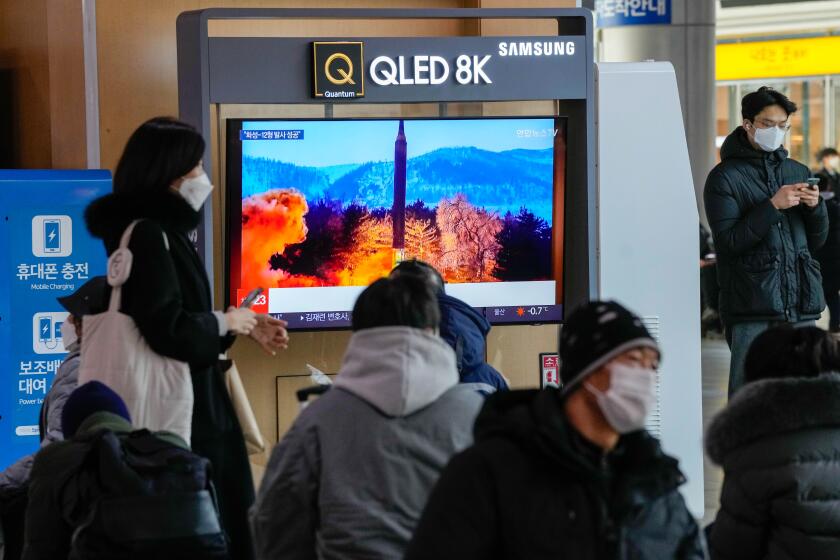North Korea fired an old ICBM, not a big new one, last week, Seoul says

- Share via
SEOUL — South Korea on Tuesday dismissed North Korea’s claim to have launched a newly developed intercontinental ballistic missile last week, saying the North fired a less-powerful existing weapon and fabricated data following an earlier failed launch.
North Korea had said that it launched a Hwasong-17 missile, its longest-range developmental ICBM, last Thursday in its biggest weapons test in years. Its state media called the launch “a historical event” and released a Hollywood-style video showing leader Kim Jong Un, in sunglasses and leather jacket, supervising the launch.
But South Korea’s Defense Ministry said Tuesday that it had determined the fired missile was a Hwasong-15, a different ICBM successfully tested in 2017.
Both the Hwasong-15 and Hwasong-17 are potentially capable of reaching the U.S. mainland. But analysts say the Hwasong-17 has a longer potential range, and its huge size suggests that it’s designed to carry multiple nuclear warheads to defeat missile-defense systems. Believed to be about 82 feet long, the Hwasong-17 is, by some estimates, the world’s biggest road-mobile ballistic missile system.
The South Korean Defense Ministry said it told a parliamentary committee that details of Thursday’s launch — such as the missile’s speed, combustion and stage separation — were similar to those of the Hwasong-15, not the Hwasong-17. The ministry’s report to the committee also suggested that the North Korean video wasn’t shot on the actual launch date, citing an analysis of Kim’s shadow and weather conditions seen in the video.
The report said the U.S. agreed with the South Korean assessment and is separately analyzing the launch.
The test launch is North Korea’s most significant in five years as it tries to pile more pressure on the Biden administration for sanctions relief.
On Monday, Japanese Chief Cabinet Secretary Hirokazu Matsuno said Tokyo’s assessment that North Korea had launched a new type of ICBM remained unchanged. Matsuno said the new missile posed a greater threat to Japan and the international community than other weapons North Korea has fired.
Thursday’s launch was North Korea’s most serious provocation since its Hwasong-15 launch in November 2017. It was also the latest in a slew of missile tests it has conducted this year in an apparent bid to modernize its arsenal and ramp up pressure on the Biden administration amid stalled nuclear talks between the two countries.
According to assessments by both North Korea and its neighbors, the missile fired last Thursday flew higher and longer than any other North Korean weapon tested. Some experts say North Korea may have mounted a much lighter payload on the Hwasong-15 to help it fly further than its previous launch in 2017.
The South Korean Defense Ministry said the alleged North Korean deception was likely related to a previous failed attempt to launch the Hwasong-17 earlier this month.
The White House plans to impose additional sanctions on North Korea for two recent ballistic missile tests that it says were efforts to test its ICBM capabilities.
According to South Korean accounts, a missile fired from North Korea’s capital region March 16 exploded soon after liftoff and many residents of Pyongyang witnessed the midair blast. The ministry report said North Korea was believed to have then decided to launch a reliable older-model ICBM to prevent possible public anxiety and bolster unity at home.
The report said it was also likely that Pyongyang attempted to deceive its rivals into believing it has advanced ICBM technology to cement its image as a military power and increase its leverage in future negotiations.
Colin Zwirko, a senior analyst at the North Korea-focused website NK Pro, said commercial satellite images indicated that North Korean state TV video of Thursday’s launch was likely shot on a different date. He said this raised the possibility that North Korea botched a Hwasong-17 test March 16.
Prior to the failed March 16 launch, the South Korean and U.S. militaries said North Korea tested a Hwasong-17 system twice earlier this year in launches that flew medium distances. Some observers said North Korea was likely testing the first stage of the Hwasong-17, but Pyongyang said only that it was testing cameras and other systems for a spy satellite, without disclosing what missile or rocket it fired. The North didn’t comment on the failed launch.
South Korean officials said this week that North Korea may raise tensions further in coming weeks by conducting another ICBM test, a prohibited launch of a rocket to place its first functioning spy satellite into orbit or even a nuclear test.
More to Read
Sign up for Essential California
The most important California stories and recommendations in your inbox every morning.
You may occasionally receive promotional content from the Los Angeles Times.















